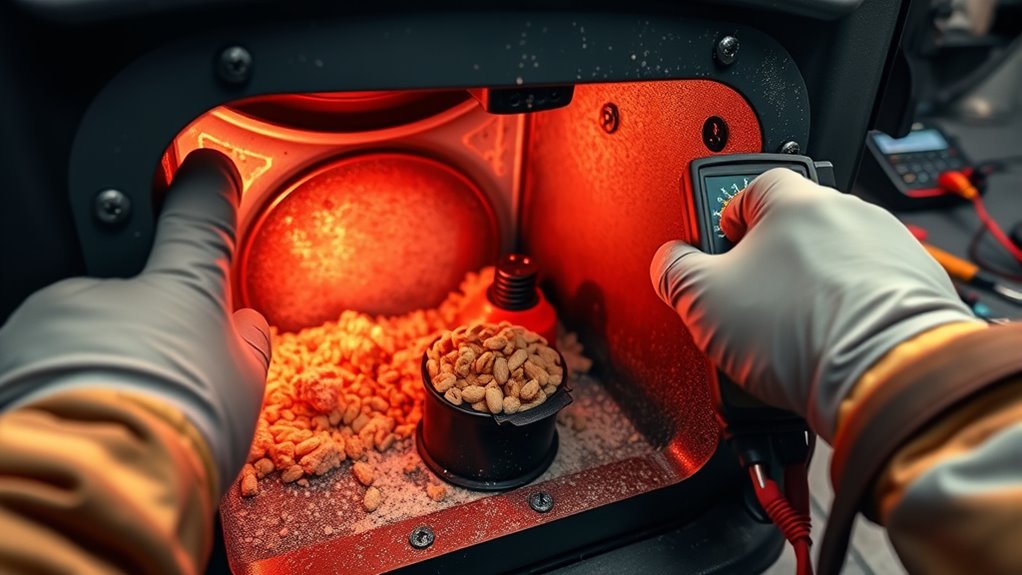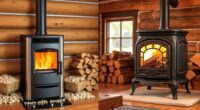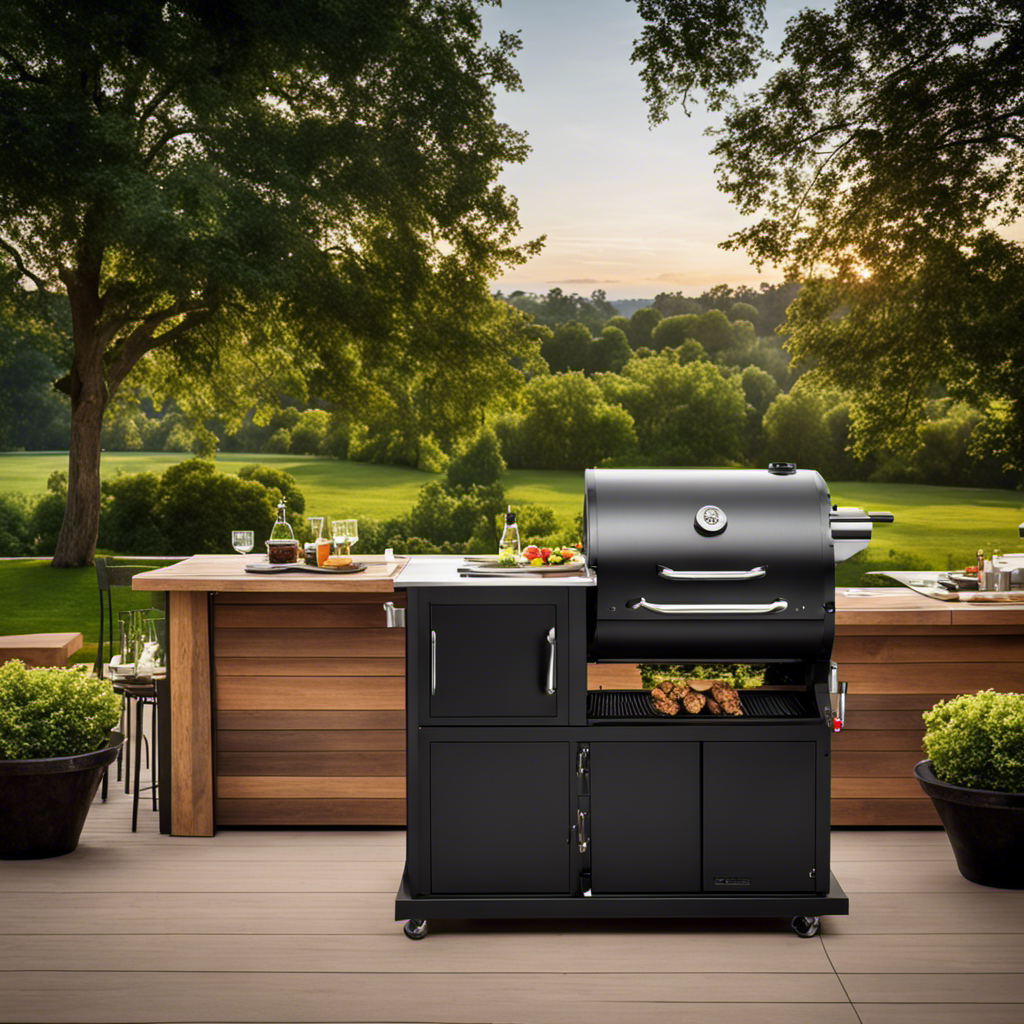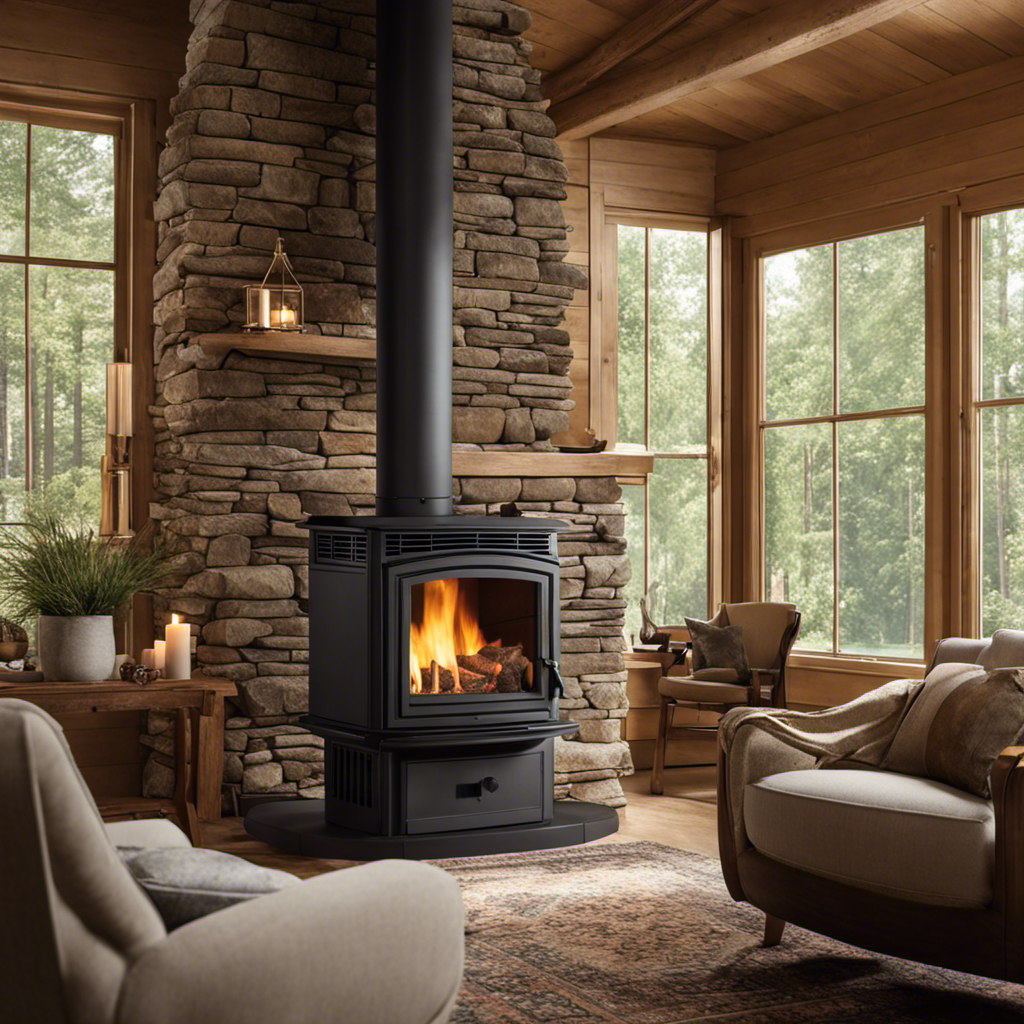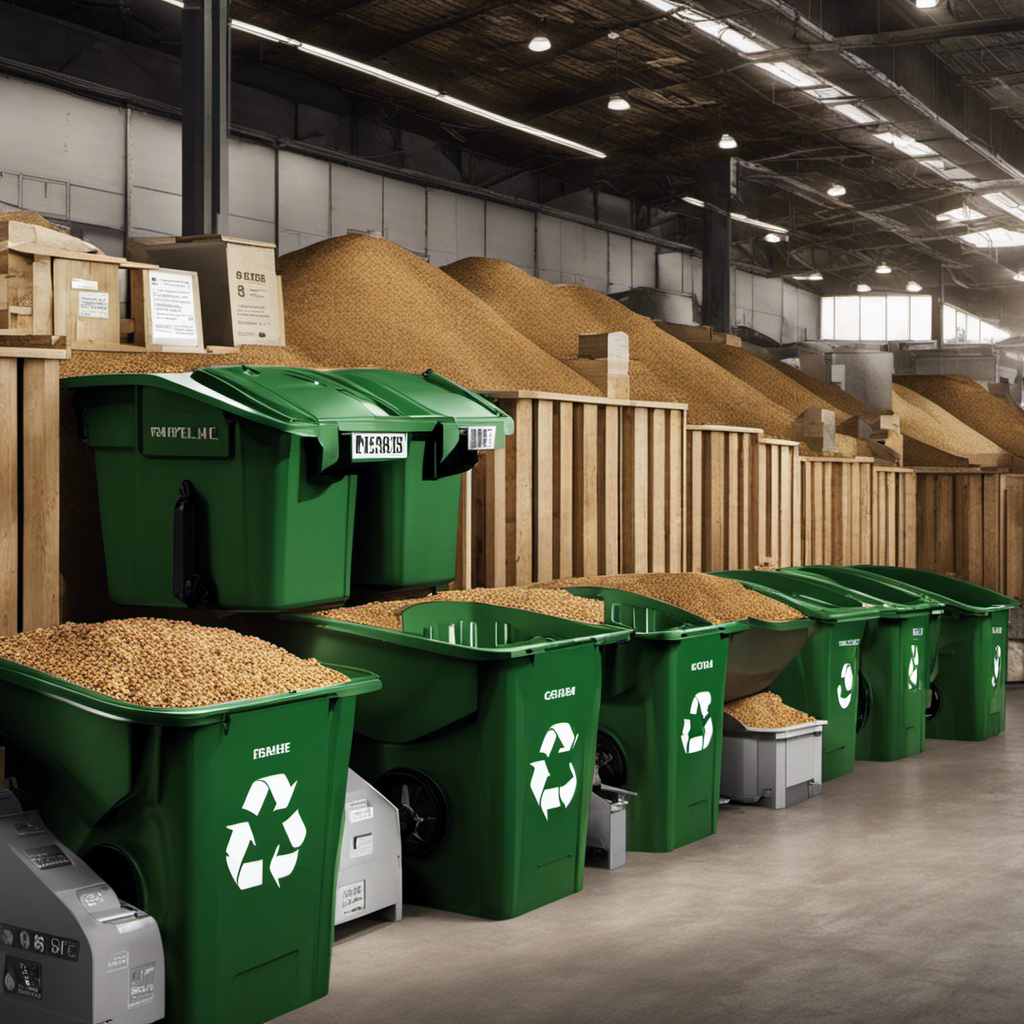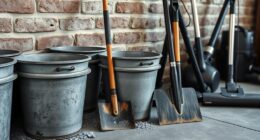To troubleshoot common pellet stove issues, start by checking the ignition system, electrical connections, and airflow to prevent startup failures. Clean the burn pot and venting to improve heat output and combustion efficiency. Inspect the hopper and feed system for jams, and ensure the pellets are high-quality and dry. Address noise or error codes by examining fans, sensors, and control panels. For persistent problems, exploring detailed steps can help you restore your stove’s safe and efficient operation.
Key Takeaways
- Check and clean the ignition system, airflow pathways, and electrical connections to ensure reliable startup and proper drafting.
- Adjust airflow settings and inspect venting for optimal combustion efficiency and heat output.
- Use high-quality, dry pellets and regularly clean the burn pot and feed system to prevent jamming and excessive ash buildup.
- Monitor for error codes, interpret control panel alerts, and reset or replace faulty components as needed.
- Perform routine maintenance, including vent cleaning and component inspections, to prevent inefficiencies and ensure safe operation.
Diagnosing Ignition and Startup Failures

When your pellet stove fails to ignite or start properly, the first step is to identify the underlying cause. Check the ignition system—faulty igniters or dirty tips can prevent the pellets from catching fire. Also, examine the electrical connections; loose wires or blown fuses can stop essential components from working during startup. Ensure the control board receives a proper proof of fire signal, like from RTD probes or thermocouples. Inadequate airflow caused by clogged vents, dirty burn pots, or malfunctioning blowers can also hinder ignition. Power issues, such as faulty wiring or blown fuses, disrupt the electrical flow needed for ignition and startup. Regular maintenance, including cleaning the igniter and inspecting electrical connections, helps prevent these failures and guarantees reliable startup. Additionally, understanding GMC tuning principles can aid in maintaining the electrical and mechanical systems that support your stove’s performance. Ensuring the correct airflow management can significantly improve ignition success and overall stove efficiency.
Addressing Poor Heat Output and Incomplete Combustion
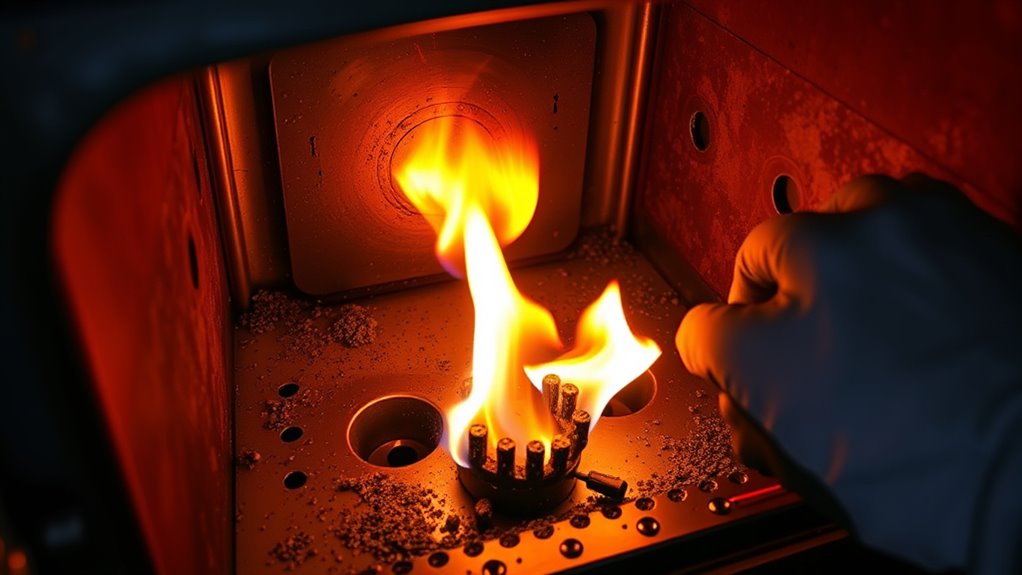
To improve heat output and guarantee complete combustion, start by optimizing your stove’s airflow settings; adjusting the damper or air intake can make a big difference. Next, check that you’re using high-quality, low-moisture pellets since poor fuel leads to uneven burning. Regular cleaning of the burn pot and exhaust system also helps maintain proper airflow and maximize heat production.
Optimize Airflow Settings
Adjusting airflow settings is crucial for guaranteeing your pellet stove produces adequate heat and burns fuel efficiently. Proper airflow, which includes modifying the combustion air intake and venting, directly impacts flame size and heat output. If you notice weak flames or poor heat, try increasing the combustion air to improve airflow and promote complete combustion. Regularly inspect and clean venting systems to prevent obstructions that restrict airflow and cause incomplete combustion. Adjust the damper or air intake controls to maintain a bright, steady flame, reducing low heat issues and boosting stove efficiency. Additionally, ensure that blowers, sensors, and other airflow control components are calibrated correctly. Maintaining ideal airflow paths helps prevent blockages and ensures your stove runs smoothly, providing consistent warmth and fuel efficiency. Proper airflow management is also essential for optimal combustion efficiency, which impacts fuel consumption and emissions. Incorporating proper maintenance routines can further enhance airflow and overall stove operation, preventing future issues and extending the lifespan of your equipment. Regularly checking and adjusting airflow settings based on industry standards helps maintain optimal stove performance and safety.
Ensure Proper Pellet Quality
Using the right quality pellets directly impacts your stove’s heat output and combustion efficiency. High-moisture-content pellets (above 10%) cause poor combustion and reduce heat, so always choose dry pellets. Pellets with excessive dust or debris block airflow in the burn pot, leading to incomplete combustion and smoky operation. Store your pellets in a dry environment to prevent moisture absorption, ensuring consistent burn quality and ideal heat production. Reputable pellet brands that meet industry standards offer uniform size, low ash content, and better combustion efficiency. Regularly inspect and remove any pellet debris or clumps from the hopper and feed system to prevent feeding blockages. Proper pellet storage is essential for maintaining a clean, efficient, and effective stove operation. Additionally, using high-quality pellets can significantly improve overall stove performance and longevity, especially since the pellet quality directly influences combustion and heat output. Proper maintenance and understanding of combustion efficiency can further optimize your stove’s performance and extend its lifespan.
Resolving Pellet Feeding and Auger Jamming Problems
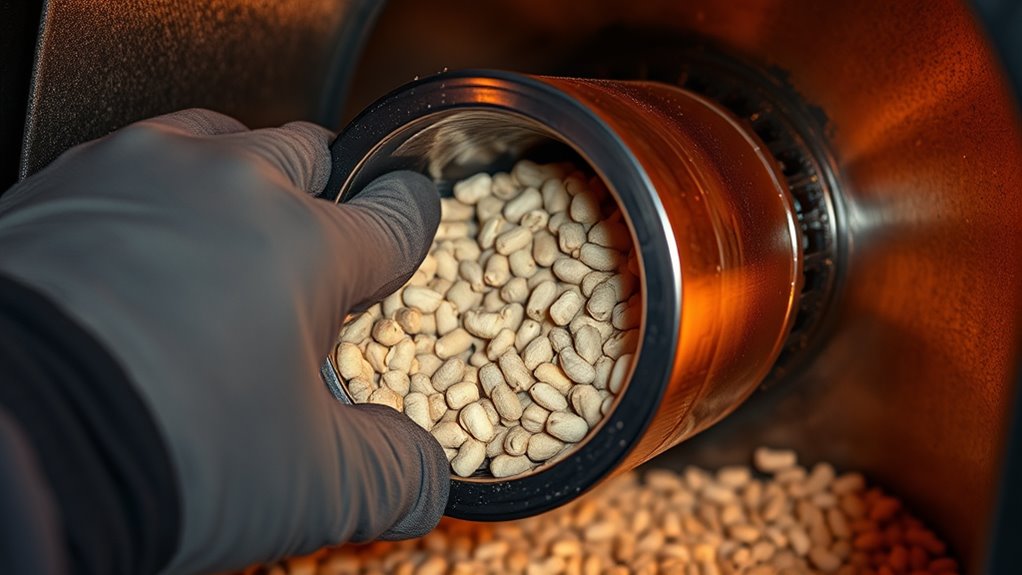
Pellet feeding and auger jamming issues are common problems that can disrupt your stove’s operation, but they’re often easy to fix with proper maintenance. To prevent pellet feed blockages, check and clean the feed system regularly, removing dust and debris. Make sure the auger chain tension is correct—about one inch of slack—to ensure smooth pellet movement. Inspect your pellets to confirm they’re free of plastic or foreign objects, and avoid overfilling the hopper to prevent bridging. Additionally, verify that the feed plate’s trip edge faces upward when reinserted, as reversing it can cause feeding issues. Consistent cleaning and inspection of these components can help you avoid auger jamming and keep your pellet stove running efficiently. Implementing regular maintenance routines can further enhance your stove’s performance and longevity. Regularly monitoring the feeding mechanism for signs of wear can also prevent unexpected breakdowns and ensure reliable operation. Ensuring the pellet quality remains high and free of contaminants is essential for smooth feeding and avoiding clogs. Incorporating on-device AI capabilities, similar to those in mobile processors, can assist in diagnosing and alerting you to potential issues before they become serious.
Fixing Excessive Ash Buildup and Burning Inefficiencies
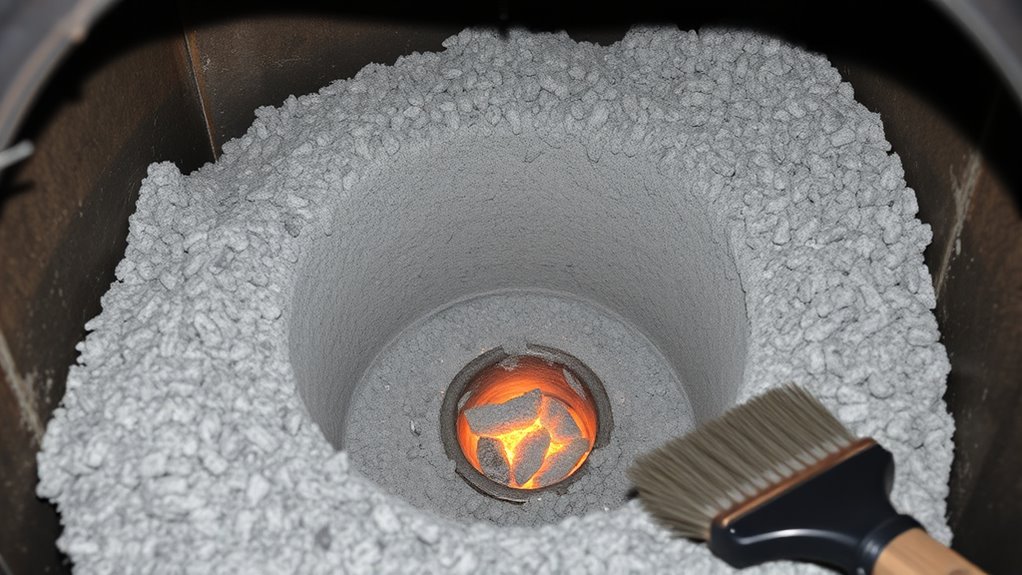
To reduce ash buildup and improve burning efficiency, start by using high-quality, low-moisture pellets. Make sure you clean the burn pot regularly and check that airflow is properly adjusted. These steps will help your stove burn cleaner and run more efficiently. Regular maintenance and understanding pellet quality are essential for optimal performance. Additionally, selecting appropriate eye patches can enhance your skincare routine, ensuring better hydration and anti-aging benefits that support overall eye health. Proper stove operation techniques, such as adjusting airflow and pressure, can also significantly decrease ash accumulation and improve combustion efficiency. Incorporating Kia Tuning techniques, such as ECU remapping and suspension upgrades, can further optimize your vehicle’s performance and reliability. Understanding the importance of fatherhood can inspire a sense of responsibility and care in maintaining your stove properly.
Use High-Quality Pellets
Choosing high-quality pellets with low moisture content and consistent size can considerably reduce ash buildup and improve combustion efficiency. When you select high-quality pellets, you’ll notice less residue and smoother operation. To maximize benefits:
- Use pellets with moisture below 8% for cleaner burning.
- Choose consistent-sized pellets to prevent feed system blockages.
- Store pellets in a dry, sealed environment to maintain quality.
- Opt for reputable brands that meet industry standards for minimal ash production.
Regularly Clean Burn Pot
Have you noticed your stove’s performance declining or excessive ash buildup? Regularly cleaning the burn pot is essential to prevent ash buildup that can block air holes and hinder airflow. A clean burn pot ensures proper pellet ignition, reduces clinker formation, and keeps heat output consistent. If ash accumulates, it can cause inefficient combustion, leading to higher pellet consumption and poor heat quality. Cleaning the burn pot every three days helps maintain ideal airflow and prevents ash from obstructing critical air passages. Using high-quality, low-moisture pellets can also reduce ash production, making cleaning easier and less frequent. Regular cleaning of the burn pot not only improves stove performance but also extends its lifespan, ensuring it operates efficiently and safely over time. Additionally, understanding the importance of proper maintenance can help prevent common issues and optimize your stove’s efficiency. Incorporating regular inspections is advised to identify early signs of wear or buildup that could impact operation. Maintaining a clean burn pot also supports the operation of airflow components, preventing blockages that could lead to stove shutdowns or uneven heating. Being aware of pellet quality and selecting appropriate fuel can further enhance stove performance and reduce maintenance needs. Recognizing that angel number symbolism may offer motivational guidance can also encourage consistent upkeep and attentive stove care.
Adjust Airflow Properly
Adjusting the stove’s air intake damper correctly is essential for ideal combustion and minimizing ash buildup. Proper airflow settings improve burning efficiency and reduce excess ash caused by incomplete combustion. If you notice too much ash or clinkers, try these adjustments:
- Increase airflow by opening the air intake damper slightly to promote complete combustion.
- Test different airflow settings to find the balance that prevents overfiring.
- Lower the damper or reduce pellet feed if ash buildup becomes excessive.
- Regularly calibrate the damper according to manufacturer guidelines for consistent results.
- Ensuring proper ventilation and airflow management can further optimize stove performance and reduce ash accumulation. Proper airflow control is crucial for maintaining a clean burn and preventing clogging of the system.
- Maintaining a clean burn pot and heat exchanger further enhances airflow effectiveness. Correct airflow adjustment ensures cleaner burning, less ash, and excellent stove performance.
Troubleshooting Noisy Operation and Unusual Sounds
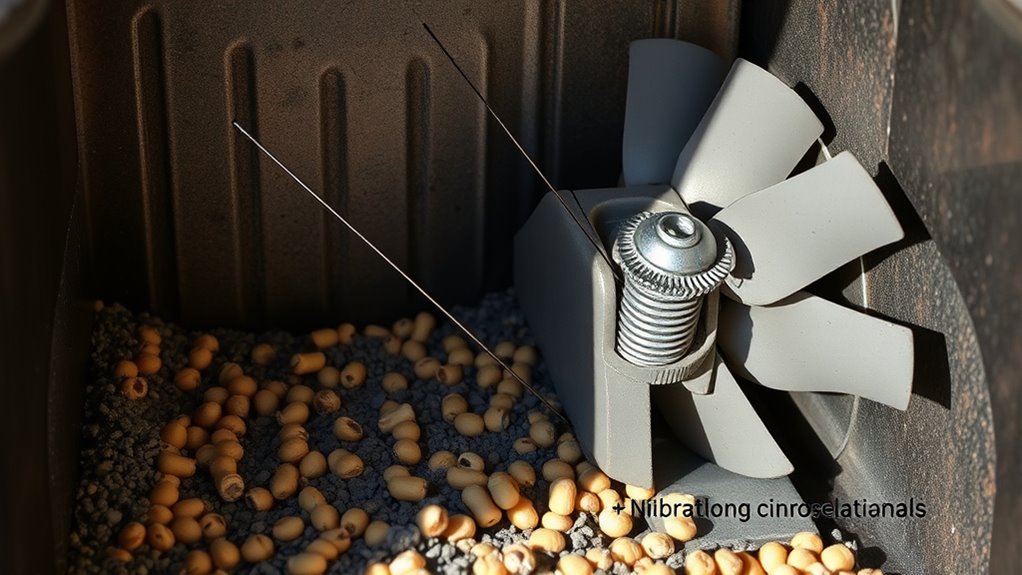
When your pellet stove starts making unusual noises, it’s often a sign that something isn’t working quite right. A rattling, banging, or high-pitched squeal usually points to loose or worn blower components, such as the blower wheel or fan. Vibrations or grinding sounds may come from debris caught in the fan blades or a misaligned blower assembly, both needing cleaning or realignment. Loud fan noises or rattling often result from dirt buildup on the blower or motor, so regular cleaning is essential. Worn bearings or failing motor parts can cause whining or squealing sounds, requiring inspection and possible replacement. Persistent banging or popping might be due to thermal expansion or debris in the combustion chamber—check and clear these to prevent further issues.
Managing Error Codes and Control Panel Alerts
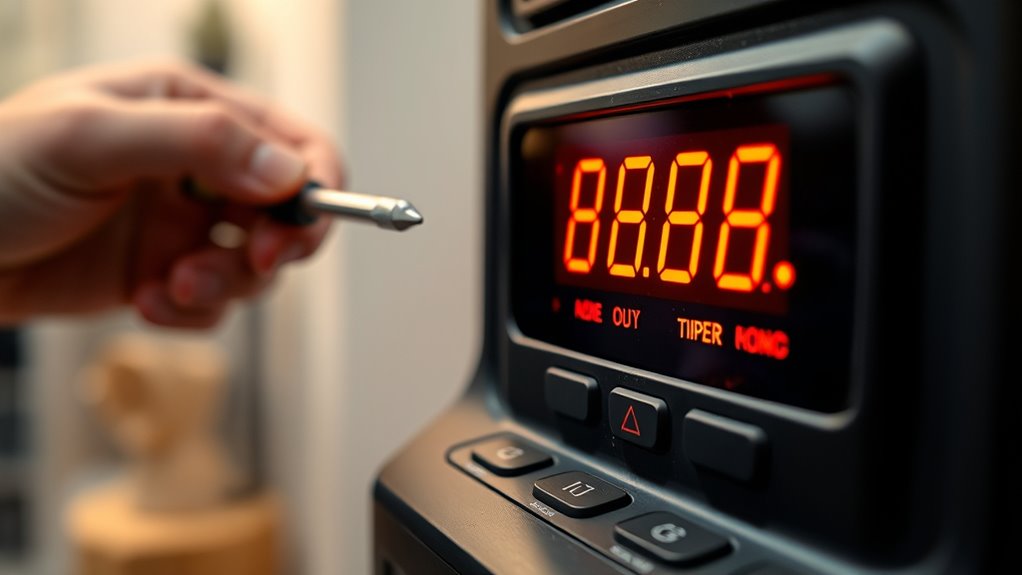
Understanding and managing error codes and control panel alerts is essential for keeping your pellet stove running smoothly. These indicators help you identify specific issues quickly, making troubleshooting more efficient. When an error code appears, it often corresponds to problems like flame failure, sensor malfunctions, or overheating. To effectively troubleshoot:
Monitoring error codes and alerts ensures your pellet stove operates safely and efficiently.
- Always refer to your stove’s manual to interpret control panel alerts and error codes.
- Observe blinking lights or numeric codes on the control panel for clues.
- Reset the control panel or power cycle the stove to clear some error codes.
- Persistent alerts may require inspecting or replacing components.
Regularly monitoring your control panel lets you catch early warning signs, preventing major malfunctions and ensuring safe operation.
Correcting Drafting and Ventilation Issues
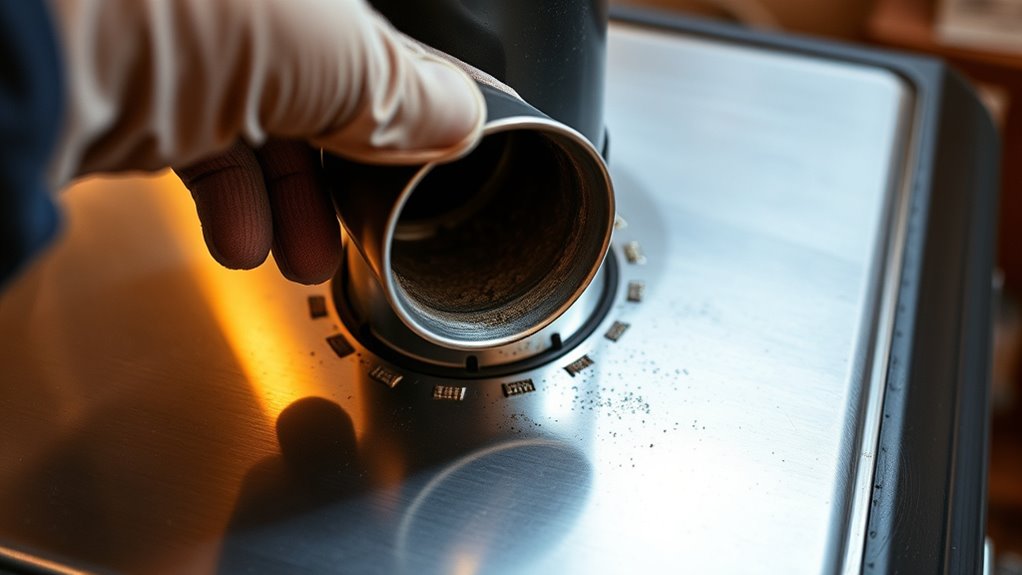
Proper venting plays a vital role in maintaining your pellet stove’s performance and safety. An effective venting system guarantees adequate airflow, preventing smoke backdrafts and supporting consistent combustion. Regularly inspect and clean your vent pipes and exhaust outlets to remove obstructions that can impair drafting. Poorly installed venting, with sharp bends or leaks, can cause a weak draft, reducing stove efficiency and risking dangerous emissions. External factors like wind gusts or negative pressure inside your home can disrupt airflow, leading to puffbacks or shutdowns. To correct these issues, keep your venting system straight, sealed, and free of blockages. By maintaining proper airflow through your venting system, you ensure your pellet stove runs smoothly, efficiently, and safely.
Frequently Asked Questions
What Causes a Pellet Stove to Not Feed Pellets?
When your pellet stove isn’t feeding pellets, it’s usually due to an auger jam, blockage, or worn drive motor that stops pellets from reaching the burnpot. Long or bridging pellets in the hopper can block the feed, while dust or debris can clog the system. Faulty sensors or incorrect auger chain tension might also signal the stove to halt pellet delivery, causing feeding problems.
Why Are My Pellets Not Burning Completely?
If your pellets aren’t burning completely, you probably have dirty burn pots or clogged air vents that restrict airflow. Using wet or low-quality pellets can cause uneven burning and excess ash. Check your air-to-fuel ratio settings—too little airflow or too high feed rate can cause incomplete combustion. Also, inspect the exhaust system for blockages, and make sure your fire sensors are clean and functioning properly.
How Do You Know if Auger Is Bad on a Pellet Stove?
If you’re wondering how to tell if your pellet stove’s auger is bad, start by listening for unusual noises like grinding or squealing, which can signal worn bearings or motor issues. Check if pellets aren’t feeding properly—slow, uneven, or no feeding at all. Visually inspect the auger for cracks, debris, or broken teeth. If it’s jammed or damaged, it’s likely time to repair or replace it.
Why Does My Pellet Stove Keep Shutting Off?
If your pellet stove keeps shutting off, it’s likely due to safety features kicking in. Check if the proof of fire sensor is dirty or faulty, as it might not detect combustion properly. Also, inspect vents and blowers for clogs, and guarantee the exhaust pathway isn’t blocked. Overheating, a jammed auger, or electrical issues like faulty wiring can also cause it to turn off unexpectedly.
Conclusion
By tackling these common pellet stove issues, you’ll keep your heater running smoother than a well-oiled machine. Don’t let a small problem turn into a disaster that ruins your cozy comfort—think of your stove as the heart of your home and treat it accordingly. With patience and a bit of troubleshooting, you’ll restore warmth and efficiency faster than you can say “fire up.” Keep these tips handy, and your stove will never let you down when you need it most.

